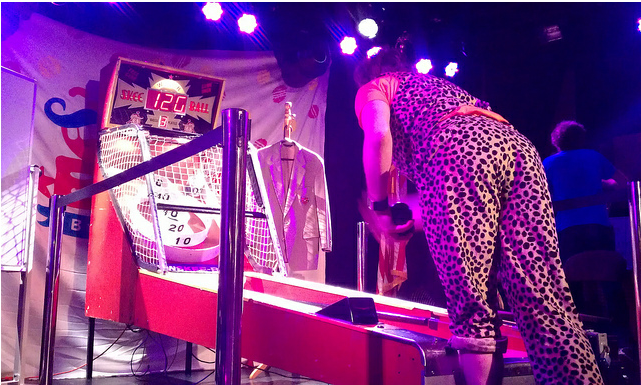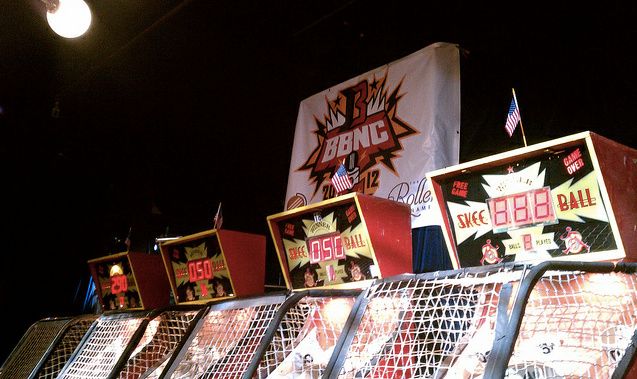Vintage 1970s Photos Show Lost Sites of NYC's Lower East Side
A quest to find his grandmother's birthplace led Richard Marc Sakols on a mission to capture his changing neighborhood on film.


 Photo by Larissa Zimberoff
Photo by Larissa Zimberoff
Last Sunday Joey Mucha, a twenty-five year old web marketer from San Francisco, started the morning at a downtown Manhattan hotel with his parents, and a breakfast buffet: scrambled eggs, two sausages, a Belgium waffle, and a little fruit. When they finished they headed back to their room to watch a few inspirational sports videos on YouTube and, with the time left, Joey took a short nap. When he woke, he donned his custom made game outfit of brown, spotted, fake fur pants and matching vest, an orange T-shirt and black skateboarding shoes. Then they hailed a cab for Brooklyn.
Jeremy and his wife Sidney, wearing clothes “she would normally never wear,” leopard pants, leopard badge lanyard, leopard earrings, and
leopard barrette, came all the way from Beaverton, Oregon to escort their son, Joey, to the Third Annual Brewskee-Ball National Championship (the BBNC) at the Knitting Factory in Williamsburg, Brooklyn. They each travelled almost three thousand miles to play—or watch—a game usually only witnessed inside the hallowed walls of amusement parks and Chuck E. Cheese’s.
Skee-ball, a game invented in 1909, is much like bowling, sharing many of the same components: balls, frames, lanes, loud shirts and funny nicknames. Its few differences, an inclined lane and point-value holes to drop into, rather than pins to knock over, are quite possibly
what has kept it in the arcade arena rather than say, the Olympics. Like other pro sports, skee-ball involves a great deal of superstition. This ranges from always wearing chapstick, tapping balls together before rolling, playing with one hand in a pocket and, in Joey’s case, rolling your left pant leg up to knee-height and pressing your shin firmly up against the skee-ball machine for what Joey referred to as, “skin-on-skee-ball machine action.”
According to his dad, Joey was a sports prodigy from a young age, when he noticed he threw the ball really straight, unlike the other kids, “You know, who threw in any direction.” When he began, his dad said, “He was a hundo-only roller. His best streak was eight in a row.” Hundreds, the absolute hardest score to roll, are only rolled in competition when a player is up the river. Ever since he “saw the light,” when he began focusing on the 40 pocket, Joey the Cat—his roller name—has been the person to beat. The fact that the reigning champion hailed from San Francisco was not going over well with the mostly New York-based crowd.
 Photo by Larissa Zimberoff
Photo by Larissa Zimberoff
“Are you a roller?,” seemed to be the unofficial skee-ballers form of introduction. The sixty-four finalists were made up of rollers from the four official leagues in New York, Wilmington, Austin and San Francisco. The players were listed in pairs on a giant bracket board on the stage. Joey made quick work of his first three challengers, two girls from Wilmington, North Carolina, Mary and Tracy, and Koda Chroma, who wasn’t too happy about the early pair off with Joey but seemed good-natured about his bad luck. A common sign of skee-ballers: they were supportive and positive, even when they lost.
It was about this time when the Skee. E. O of the games, Eric Pavony, unveiled Purple Lane, a treasured machine used only in competition. As the DJ played Purple Rain by Prince, Pavony announced “the ornate eight,” the eight semi-finalists, who walked up to the stage, accepting their sashes of colored crepe paper and taking their seats, in single rows flanking the dedicated machine, then Pavony kicked off the final rounds with a, “Let’s get skeerious.”
Next up in Joey’s bracket was Snakes on a Lane, who, despite his flashy name, looked like he might be more comfortable in front of a computer monitor then on a stage. Snakes pulled ahead to a promising start with the crowd yelling their support. He looking uncomfortable with the attention and tried to hold onto the lead but it was the Cat’s game. Joey won by three points.
Taller, bigger and more bearded, Brewbacca, the next challenger, wearing a blue shirt with a giant B on the front looked hard to beat. The fans went mad, cheering fingers-in-ears loud every time he stood up, yelling his tagline, which sounded much like booing, but was actually his name, “Brewwwww.” In comparison, the Cat received an infrequent “Meow.” In the end, Brewbacca became just another roller who didn’t win, handing Joey one of his precious cards, a skee-ball tradition where the losing player hands the winner one of his player cards.
As evening was settling in outside, inside the dark bar was, still dark. Joey grabbed his Franklin dry rosin bag, tossed it back and forth, then clapped his hands, cheering himself on in a poof of chalky dust, showing the crowd he was ready for his final round against Buck Wild, a somewhat diminutive guy from New York.
Buck Wild held onto the lead for a few early frames, throwing high-fives to the audience. But his game began to slip, missed 50s becoming 10s. It was just the opening Joey the Cat was waiting for. With his laser focus on his 40s only game, Joey grabbed the lead.
It was the final frame of the night, of the entire league championship. In desperation Buck Wild turned to the speculative hundo. Buck landed only one. Joey the Cat, fist pump to the air, showed the cheering crowd his claws and snarled his lips. Then he put on his prize, a cream blazer with BBNC patch, and grabbed his giant-sized check for three thousand dollars made out, “For: the love of the lane.” In the back of the room, his mom danced around on an unused machine and his dad smiled nearby. With pride? “Sure,” he said, “Something like that.”
Subscribe to our newsletter